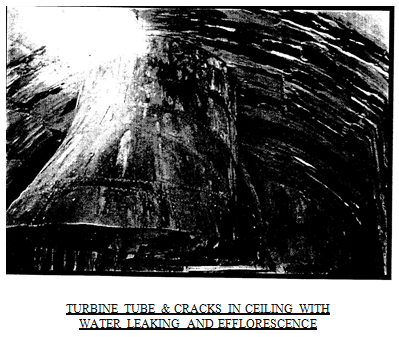 Underwater Inspection and Evaluation
Underwater Inspection and Evaluation
“A Critical Component” for Preventative Maintenance, Operation and Relicensing
William J. Castle, P.E.
W.J. Castle, P.E. & Associates,
P.C. 693 Main Street, Building B, Suite 1
Lumberton, New Jersey 08048 USA
TYPES OF DAMS
A. Dam Structures
Dams are generally classified under the following categories:
- Gravity
- Arch
- Buttress
- Earth
- Rock-Fill
- Hydro-Electric Dam
Hydro-Electric Dams can be concrete arch, buttress, or Gravity with the following turbine units:
- Francis Type Turbine consists of the following four essential parts:
Scroll case which transfers the water from the penstock (supply pipe) to the wicket gates and runner.
Trash racks, head gate @Forebay, Stop Log (End of Draft Tube). Wicket gates control the amount of water to the turbine(s).
Runner is part of the turbine which transfers water energy into useful work. Draft tube is a conical tube which decelerates the flow discharged from the runner.
- Propeller – Type Turbine
Has the same basic parts as the Francis Turbine with the basic difference in the shape of the runner. Runner operates in the same manner as a fan or a ships propeller.
Critical area on dams to be inspected are the Water Relief Structures which are usually classified as follows:
1. Spillways
-
-
- Overflow Spillway – Used with concrete dams and constructed of concrete.
- Ogee Spillway
- Chute Spillway
- Side-Channel Spillway
- Shaft Spillway
- Siphon Spillway
-
2. Crest Gates
-
-
- Flashboards and Stop Logs – small installations under low head.
- Taintor Gates – vertical sliding gates – mounted on low fricting roller
- Bearings are used primarily on major installations.
- Bear Trap or Drum Gates
-
B. Critical Areas To Be Inspected:
- Concrete surfaces for excessive scaling or cracking
- Scouring or Undermining
- Tracks and Seals
- End Plate
- Lifting Lugs (If Applicable)
- Debris or Obstructions
- Misalignment or movement
- Excessive corrosion of steel
- Ice Damage
- Overflow structures and piping
REPORT AND RECOMMENDATION
The purpose of any underwater inspection is to provide the information necessary to assess the condition (capacity, safety, and rate of deterioration) of a structure. The usefulness of an inspection depends on establishing a clear and complete record. Although the level of inspection will determine the extent of information to be provided, in general, the inspection will address the following:
Generally, a final report should include the following items:
- Identification and description of all major damage and deterioration of the facility.
- Estimate of the extent of damage and deterioration.
- Identification of any problems associated with mobilization of equipment, personnel, and materials to accomplish repairs/maintenance.
- Update foundation plans (which occasionally differ significantly from the drawings available at the activity).
- Documentation of types and extent of marine growth (to help plan future inspections), as well as damage caused by their presence.
- Water depths at various locations within the dam structure.
- Water visibility, temperature, water current, ice, etc.
- Miscellaneous information for the database to assist in planning future inspections.
- Assessment of general physical condition including projected load capacities of the in-water structures of each facility inspected.
- Recommendations for required maintenance and repair (M & R).
- Budgetary estimates of costs of this M & R, including examples of the derivation of the estimates.
- Estimate of expected life of each facility.
- Recommendations for types and frequencies of future underwater inspections.
SUMMARY
“Underwater Inspection and Evaluation” is very critical in determining the overall condition of a dam structure and its components. Proper inspection by qualified technical inspectors is the key element. Since there are no established standards or criteria for diving personnel, the minimum standards are usually established by the person or persons in charge of Maintenance Programs. This results in different requirements from agency to agency. The diver performing the Underwater Inspection must have a minimum understanding of dam design, construction and working functions in order to properly inspect the structure. This is extremely critical when performing an inspection with zero visibility and the diver must inspect by “feeling” with his/her hands. If the diver does not have this minimum knowledge, how can he/she perform an accurate inspection? The Engineer in charge should also have diving experience with dam structures in order to relate and verify the diver’s information.
Developing a certification program for both divers and engineers involved in Underwater Inspections of Dam Facilities must be established on a national or international level. Until a uniform program is established, Underwater Inspections will be continued to be performed by usually the “lowest bid” and not the “most qualified”.
REFERENCES
References Materials used to develop inspection procedures and planning factors outlined in this chapter, have been taken from the following documents:
• Guidelines For Inspection And Maintenance of Marine Facilities Harbor And Ports Directorate (HPD) And Public Work Canada (PWC)
• Design of Small Dams U.S. Department of The Interior Bureau of Reclamation
• NAVFAC MO-322, Inspection of Shore Facilities, Naval Facilities Engineering Command, Washington D.C., July 1977 (reference 2).
• NCEL TM-43-85-01 O&M, UCT Conventional Inspection and Repair Techniques Manual, October 1984 (reference 36).
• CHESNAVFACENGCOM FPO-1-85(26), Guidelines For Preparation of Reports on Underwater Inspections of Waterfront Facilities, December 1985 (reference 37).
• NAVDOCKS MO-306, Corrosion Prevention and Control, Naval Facilities Engineering Command, Washington D.C., June 1964 (reference 38).
• CELL CR 81.009, Survey of Techniques for Underwater Maintenance/Repair of Waterfront Structures, Childs Engineering Corp., April 1981 (reference 39).
• Federal Highway Administration, Report No. FHWA-DP-80-1
• Federal Energy Regulatory Commission, manual FERC 0119-2 “Engineering Guidelines for the Evaluation ofHydropower Projects”
• Occupational Safety & Health Administration (OSHA)
“Diving Standards” Subpart T – Commercial Diving Operations
• American National Standards Institute, (ANSI) Commercial Diver Training Minimum Standard, ANSI/ACDE-01-1993
• Association of State Dam Safety Officials, (ASDSO)
This is part 4 of a 4-part series.
You can find part 1 here.
You can find part 2 here.
Read part 3 here.